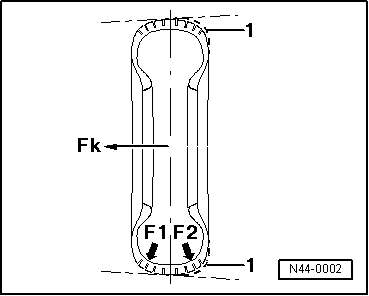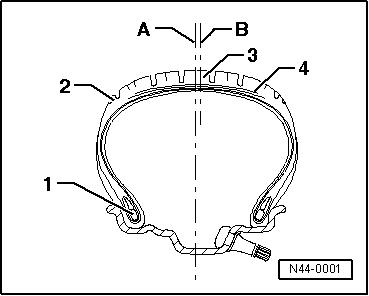| 1 - | Belt/tread off-centre |
| F1 - | Unequal vertical forces |
| F2 - | Unequal vertical forces |
| Due to this asymmetry, different degrees of rigidness occur on the interior and exterior shoulders of the tyre, leading to different contact forces of the same. As a result, the belt and the tread are not pressed with the same force (F1, F2) onto the road surface. A cone is formed. The resulting force (conicity force Fk) may become so great, depending upon the speed of the vehicle, that the vehicle pulls to one side. |
| If the force (Fk) is, for example, 50 Newton on one wheel of the axle and 50 Newton on the other wheel, if both forces act in the same direction, the forces are added together. The side pull of the vehicle can be compensated for by rotating the tyre on the wheel rim, as then the forces would be opposing. |
| Given that the direction in which the conicity force acts is not visible on the tyre, it can only be determined by making test drives and interchanging the wheels/tyres which are the cause of the lateral pull. |
| The tyre is made up of various components and different materials, partially vulcanised at the end of a complex manufacturing process. This is why different constructive tolerances arise which are noticeable due to the presence of lateral forces of greater or lesser intensity (lateral conicity forces). These forces may also appear in new tyres. |
| Pulling to one side on front axle |
| Pulling to one side can be caused by the running gear. However, experience shows that in 90% of all complaints, the tyres cause pulling to one side. |
| Pulling to one side when driving normally |
| The vehicle tends to pull to one side when driving on a straight flat road surface, at constant speed or moderate acceleration. No force is felt on the steering wheel. |
| Pulling to one side when accelerating sharply |
| Pulling to one side when accelerating sharply is partly an intrinsic phenomenon of front-wheel drive vehicles. The driving properties are considerably affected by the different wear relations between the right and left wheels, or even by irregularities in the road surface (bumps), with the resulting fluctuation in grip on the road surface. This complaint is not covered under the guarantee. |
|
|

|



